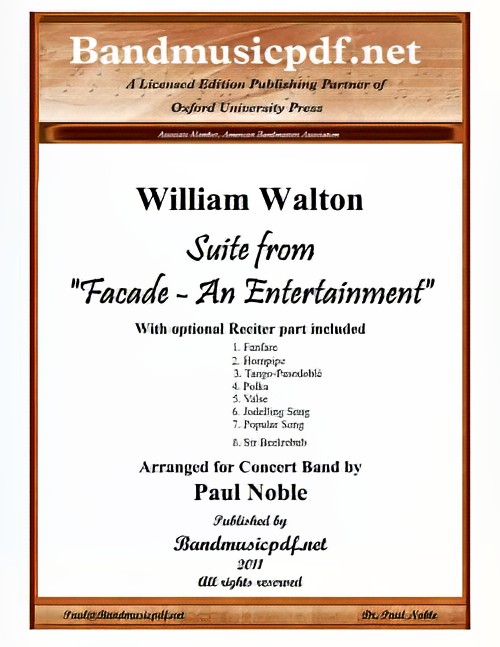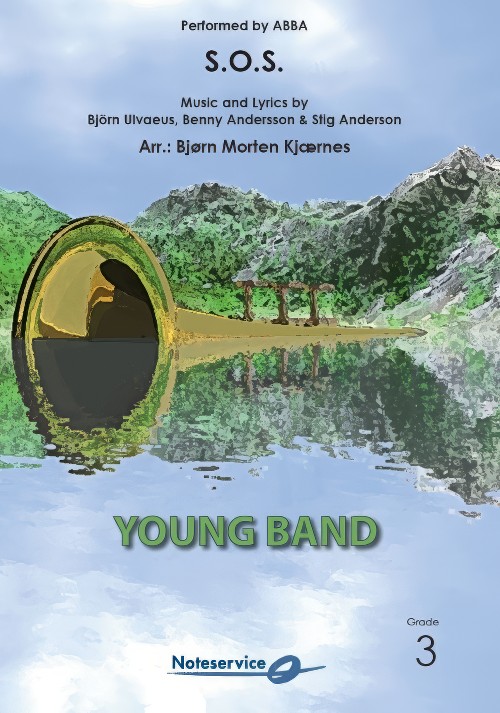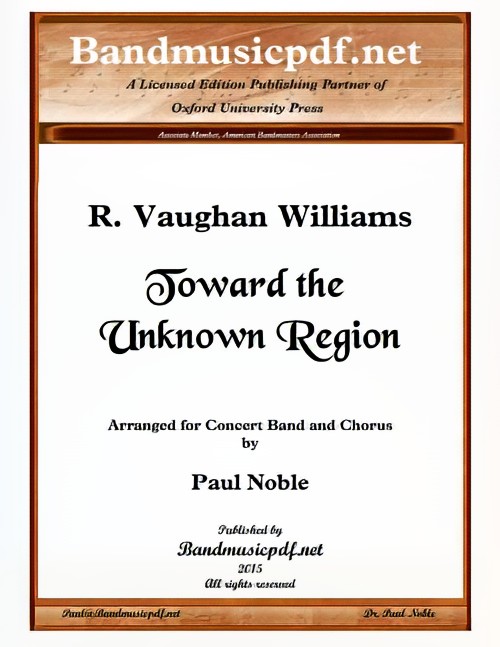Results
-
£274.99
Stone Age (Concert Band - Score and Parts) - Doss, Thomas
Stone Age, Middle Age and New Age are the three distinct sections of this single movement work at the highest level. Whilst Stone Age has a menacing and ancient atmosphere, an old German song can be made out in Middle Age - vocals, guitar, recorder or even bagpipes can be incorporated into the melody, which gradually gives up merry Celtic dances. In New Age, the 'present', the Celtic sounds finally connect with untamed, rousing dance rhythms.Duration: 18:30
Estimated dispatch 7-14 working days
-
£74.99
Bergischer March - Reiner Lüghausen
It is a tradition that a concert must include a real, classic march. Traditions are made to be kept. This is also true of our German neighbours. Reiner Lghausen obtained his inspiration from the German march literature.
Estimated dispatch 7-14 working days
-
 £274.99
£274.99Stone Age - Thomas Doss
Stone Age, Middle Age and New Age are the three distinct sections of this single movement work at the highest level. Whilst Stone Age has a menacing and ancient atmosphere, an old German song can be made out in Middle Age vocals, guitar, recorder or even bagpipes can be incorporated into the melody, which gradually gives up merry Celtic dances. In New Age, the 'present', the Celtic sounds finally connect with untamed, rousing dance rhythms.
Estimated dispatch 7-14 working days
-
 £201.50
£201.50Karneval i Paris - Johan S. Svendsen
Johan Svendsen (1840-1911) composed "Carnival in Paris" in 1872, inspired by the energy and vibrancy of the Parisian carnival celebrations. The piece showcases a variety of moods and orchestral colours, ranging from jubilant and playful sections to more lyrical and elegant passages. It is a lively and colourful work that reflects Svendsen's skill in orchestration and his ability to capture vivid, festive atmospheres in music. In "Carnival in Paris", his Nordic musical roots meet the cosmopolitan influences he encountered while living and working in major European cities. The work has become one of Svendsen's most popular and is frequently performed in concert halls and festivals. About My Transcriptions for Wind Bands Ever since I started playing the clarinet at 8 or 9 years old in the school band "Blveisene" in my hometown of Gjvik, playing transcriptions of orchestral music has been a natural part of the repertoire. In regional bands, Norway's National Youth Band, and during my 10 years in a Military band, I played many such transcriptions. These transcriptions often included handwritten parts, masterfully crafted by colleagues in a time when music notation software didn't exist. Similarly, the scores were often incomplete, typically featuring just a solo clarinet part and condensed score in Bb. The transcriptions also contained parts for instruments like the Eb cornet and multiple tenor horns, but no saxophones, which made them less suitable for modern wind bands. The rise of many skilled Concert Bands and the increasing demands for scores and accessibility made me realize that someone needed to preserve this tradition. The reason I've transcribed these works is to ensure that you can play or conduct a repertoire that I believe has a rightful place in Norwegian Wind Band tradition. These transcriptions are my contribution to preserving some of the unique works in Norwegian music literature. Creating a transcription is a complex task, and I believe the score of "Carnival in Paris" is one of the most intricate I've undertaken. The first part of the process involves entering the entire orchestral score into music notation software. This is time-consuming and requires meticulous work. The next step is to check several editions to see if there are any discrepancies. Mistakes are often found in orchestral material, which can lead to further errors in the transcription. After that, I listen to many different recordings while following along with the score, paying attention to how different conductors emphasize balance and timbre. Gradually, I begin to note down passages I believe will work well for wind bands. One particular challenge in this piece is that the woodwinds and strings operate in the same register. In the original, the tonal difference between the strings and winds helps to clarify the individual musical lines. In the transcription, I've tried to address this by separating the lines, for example through octave adjustments, and highlighting them without compromising other aspects. I've also used some mallet percussion to broaden the tonal palette. There are countless decisions to be made to create a product that will hopefully allow future generations of wind band musicians to play this repertoire. - Stig Nordhagen -
Estimated dispatch 7-14 working days
-
£144.99
Like a Child Wind Band Set (Score & Parts)
The young have the future. This is the statement made at the beginning of 'Like a Child' by Andreas Ludwig Schulte. The opening radiates strength and ambition, but one is also made to wonder which direction will be chosen, which choices will have to be made.After the introduction the first steps on the path of life are taken, still somewhat unsteadily (the 3/4th time used illustrates this uncertainty). However, the child has now set off and will meet the future with an open mind, unafraid, even though experience will teach it how easily it can be hurt.Fortunately, it is sometimes allowed to be vulnerable and it discovers there will always be someone to offer shelter, support and love. (Adagio) The last part breathes a far greater independence. Youth is able to face the future, it can even take on the whole world! 07:45
Estimated dispatch 7-14 working days
-
 £144.99
£144.99Like a Child - Andreas Ludwig Schulte
The young have the future. This is the statement made at the beginning of 'Like a Child' by Andreas Ludwig Schulte. The opening radiates strength and ambition, but one is also made to wonder which direction will be chosen, which choices will have to be made.After the introduction the first steps on the path of life are taken, still somewhat unsteadily (the 3/4th time used illustrates this uncertainty). However, the child has now set off and will meet the future with an open mind, unafraid, even though experience will teach it how easily it can be hurt.Fortunately, it is sometimes allowed to be vulnerable and it discovers there will always be someone to offer shelter,support and love. (Adagio) The last part breathes a far greater independence. Youth is able to face the future, it can even take on the whole world!
Estimated dispatch 7-14 working days
-
 £375.00
£375.00Facade - An Entertainment, Suite from (Concert Band with Optional Narrator - Score and Parts) - Walton, William - Noble, Paul
This Suite from Facade - An Entertainment, composed by William Walton, with poems by Dame Edith Sitwell, presents for the first time a grouping of movements selected and arranged by Paul Noble for Concert Band and optional Reciter. The original composition was written between 1921 and 1928, containing forty-three numbers. They had their origin in a new style of poetry that Edith Sitwell evolved in the early 1920s, poems that her brother Osbert later described as 'experiments in obtaining through the medium of words the rhythm and dance measures such as waltzes, polkas, foxtrots... Some of the resulting poems were sad and serious... Others were mocking and gay... All possessed a quite extraordinary and haunting fascination.' Possibly influenced by the dance references in some of the numbers, Osbert declared that the poems might be further enhanced if spoken to a musical accompaniment. The obvious choice of composer was the young man who lived and worked in an attic room of the Sitwell brothers' house in Carlyle Square W[illiam] T[urner] Walton, as he then styled himself. The now historic first performance of the Facade Entertainment took place in an L-shaped first-floor drawing-room on January 24, 1922. Accompaniments to sixteen poems and two short musical numbers were performed by an ensemble of five players. The performers were obscured from the audience by a decorated front curtain, through which a megaphone protruded for Edith to declaim her poems. This was, as she put it, 'to deprive the work of any personal quality'. The first public performance of Facade was given at the Aeolian Hall on June 12, 1923. By now, fourteen poems had been set, others revised or rejected, and an alto saxophone added to the ensemble. The occasion gave rise to widespread publicity, both pro and contra, and the name of the twenty-one year old W. T. Walton was truly launched. In the ensuing years the Facade has gone through revisions and additions, with full orchestral arrangements of selected movements being made without the Reciter. Former Band Director Robert O'Brien arranged some movements for band, again without Reciter, which are now out of print. So this 'history making' addition is the first opportunity for Concert Bands to present some movements of Facade with poems as originally intended. The luxury of electronic amplification allows the full ensemble to perform without necessarily overshadowing the Reciter. And the arrangements are written with considerable doubling so that the ensemble may play in full, or reduced in size as may be desired for proper balance. And, though not encouraged, the arrangements are written so that the band can perform the music without the Reciter. Program notes are adapted in part from those written by David Lloyd-Jones and published by Oxford University Press in the Study Score of William Walton's Facade Entertainments.
Estimated dispatch 7-14 working days
-
 £174.10
£174.10Finale from The New World Symphony - Antonin Dvorak
This arrangement was written for Norwegian School Band Madlamark Skolekorps to their participation at the Norwegian Championships 2023.The arrangement will work excellent also for a wind ensemble (one player to each part), but the clarinet parts should always be doubled.Euphonium II is optional, but it's recommended to use also this when there are two players or more on this instrument. Concerning percussion, timpani is the most important part, but it's recommended to also cover cymbals and mallet percussion.The articulation and dynamics are kept as close as possible to the original version by Dvorak. However, some changes has been made to make it more suitable for a wind instrumentation. The timpani part is identical to the original version except for some places when the trumpet signals are doubled in the timpani part.Staccato notation should not be played short here, but rather separated. At faster passages, the music should be played endurant or legato if possible.This arrangement is a good opportunity to perform music of highest quality where musicality, phrasing, balance and intonation are very important, and, where each musician and part are deeply involved in the music making.
Estimated dispatch 7-14 working days
-
 £73.00
£73.00S.O.S. (Concert Band - Score and Parts) - Kjaernes, Bjorn Morten
When the publisher asked me to make an arrangement of an ABBA tune, S.O.S. was the first song I thought of. Its introduction and melody are well suited to play for Wind Band. Admittedly, the key had to be shifted to make it sound good for this instrumentation. To me, this is nostalgia, while for others, the Mamma Mia movie/show will be what they associate with this wonderful song. Apart from a few medleys, few of ABBA's songs are available to Wind Band. So, it was very fun to work on this classic.The arrangement is made quite simply to fit many sizes of bands. Technically, it is also relatively simple both in range and rhythm. As you can see, there are many ways to adjust this arrangement to your own ensemble. Bring out melody lines and the bassline, and a lot is done. If needed, simplify to make it sound nice.Get creative and have fun!- Bjorn Morten KjaernesDuration: 3.30
Estimated dispatch 7-14 working days
-
 £250.00
£250.00Toward the Unknown Region (Choir with Concert Band - Score and Parts) - Williams, Vaughan - Noble, Paul
This magnificent setting of Walt Whitman's poem established Vaughan Williams's reputation as one of the leading composers of the twentieth century. The idea of a spiritual journey - the passage of the soul from darkness to light, Toward the Unknown Region - is central to the text and fully reflected in the music. Beginning softly and simply, the music follows the text of the poem, building through a Wagnerian chromaticism toward a bold and dramatic climax. This was Vaughan Williams's first major choral piece, and its obvious inspirational qualities made it a success from the first. This arrangement for Concert Band and Chorus adheres to the original orchestration. The choral parts are included in the conductor's score as a reference, but are not part of the set. The choral parts are available for purchase seperately.
Estimated dispatch 7-14 working days
